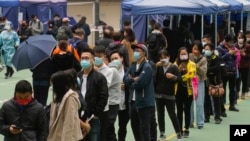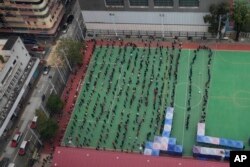The omicron variant of the coronavirus has sparked Hong Kong’s fifth wave of COVID-19 cases in recent weeks, with new restrictions being implemented Thursday by Chief Executive Carrie Lam.
Public gatherings are limited to two people, and private gatherings are limited to two families.
Hong Kong’s daily infection rate reached a record 614 cases on Monday. Wednesday saw 1,161 daily infections. Thursday recorded 986 new cases.
With the extreme transmissibility of omicron, experts are predicting that cases will rise in what is one of the world’s most densely populated jurisdictions, with more than 6,500 people per square kilometer.
Dr. David Owens, a family physician and honorary assistant clinical professor at Hong Kong University, said the recent record number of cases would only get worse.
“It’s only the beginning. I think the likeliest thing over the next few weeks is we’re going to see an increasing surge in cases. I anticipate a significant epidemic burning through Hong Kong over the next three to four months.
He added, “If we look at the attack rate from other countries — the total number of infections — it is likely omicron is going to affect the majority of the population.”
Vaccination proof
Lam announced this week that residents of Hong Kong would now need proof of a COVID-19 vaccination to enter premises in coming weeks.
Beginning February 24, residents will be required to show a “vaccine pass” to enter malls, supermarkets and religious venues. The pass will also be needed to enter gyms, bars, entertainment venues and beauty salons, which have been closed since January. Restaurant diners must also have at least one shot of the vaccine to eat at any premise.
Mask-wearing is a requirement in public, while fines for breaking social distancing regulations will be doubled to $1,283.
“Some of the measures will increase vaccination rates, for instance, the things about transport and restaurants. I think the primary focus should be boosting vaccination rates in the elderly and vulnerable,” Owens said.
Lam said that getting the elderly and the most vulnerable vaccinated was a top priority, since vaccination rates in January among those groups were “very low.”
Residents have been forming long lines outside vaccination centers in recent days. As of Wednesday, vaccination rates stand at 64.3% for those 70-79 years old, while those age 80 and older are 35.3%, according to government data.
Hong Kong has implemented a “zero-COVID” plan to stamp out the virus, a strategy aligned with China’s, which has had some success, even as most of the world is moving toward adopting ways of living with the virus.
Despite the city facing an outbreak of cases unseen before, Lam insisted the plan was still the best policy for Hong Kong.
But Owens told VOA, “The things that were introduced represented mitigation, which is sensible, but returning to zero isn’t really possible, in my opinion."
The city saw low infection rates throughout 2021 before a rare rise in cases in December. It wasn’t until the first untraceable community infections were reported on January 4 that authorities were forced into action.
The Hong Kong government quickly tightened restrictions that included the stopping of dine-in services after 6 p.m. and closing designated premises. But by the end of January, the city was facing nearly 100 new daily cases that were followed by the Lunar New Year holidays.
‘Inevitable’ surge
A medical researcher specializing in viruses in Hong Kong who requested anonymity told VOA it was “inevitable” that omicron would surge in the city.
“They implemented restrictions quickly but unfortunately, it coincided with Chinese New Year, and the data suggests that this is what drove the exponential increases in cases,” the researcher said.
Hong Kong has a population of approximately 7.5 million and is one of the most densely populated cities in the world, with many living in high-rise apartments and small living spaces.
But since the pandemic began, authorities have been quick to lock down several housing estates in efforts to trace potential cases. Residents have had to quickly undergo compulsory testing for the virus, with positive cases sent to government quarantine facilities.
“The thing about omicron in Hong Kong is the vertical transmission factor. There are a lot of old buildings with poor sewage structural integrity, so it could be happening all over the place,” the researcher said.
As of Thursday, there have been 18,794 infections and at least 216 deaths in Hong Kong since the pandemic started two years ago.
Owens believes more regular rapid testing would break virus transmission chains.
“We’ve got a situation at the moment where some people who are testing positive with rapid tests are being sent to hospital. That’s going to overload the hospitals, and even introducing infections into the hospitals and the health care workers,” Owens said.
Data show that the highly transmissible omicron variant has an incubation period of about five days and causes less severe symptoms than earlier variants.
“Key workers, or those coming into contact with the public, could test themselves daily. And when people get symptoms, they would be encouraged to test themselves. They could isolate at home for a minimum of five days or until they had a negative test, whichever was the latest,” he added.
Lam said the government was in the process of procuring millions of rapid antigen testing kits to improve detection.
Hong Kong has now administered over 11.5 million vaccinations, with 5.5 million receiving their first doses, 4.9 million fully vaccinated and 1.1 million receiving their third doses, according to official data.






